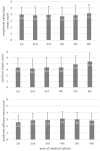Polish medical students facing the pandemic-Assessment of resilience, well-being and burnout in the COVID-19 era
- PMID: 35073318
- PMCID: PMC8786167
- DOI: 10.1371/journal.pone.0261652
Polish medical students facing the pandemic-Assessment of resilience, well-being and burnout in the COVID-19 era
Abstract
Introduction: Recent reports indicate that COVID-19 pandemic has significant influence on medical professionals' mental health. Strict limitations in clinical practice and social interactions within academic community, which had to be introduced, could lead to significant psychological distress in medical students. The aim of the study was to assess resilience, well-being and burnout among Polish medical students in the COVID-19 era.
Methods: The online survey consisting of validated questionnaires assessing resilience (Resilience Scale 14; RS-14), well-being (Medical Student Well-Being Index) and burnout (Maslach Burnout Inventory) as well as self-created survey concerning mental health problems, use of stimulants, SARS-CoV-2 infection, work in COVID-19 units, medical education and social attitude towards health care professionals in the pandemic era was distributed via Facebook and other online students' platforms. 1858 MSs from all polish medical schools agreed to fill in the survey.
Results: 'Very low', 'low' and 'on the low end' levels of resilience were found in 26%, 19.1% and 26.9% of the study group, respectively. Students with higher resilience level presented better attitude towards online and hybrid classes. 16.8% of respondents stated that they worked, currently work or plan to work voluntarily at the pandemic frontline. In terms of burnout, these respondents presented lower exhaustion (p = 0.003) and cynicism (p = 0.02), and higher academic efficacy (p = 0.002). That group also showed greater resilience (p = 0.046). The SARS-CoV-2 infection among respondents, their relatives and friends did not influence the results. 39.1% of respondents declared the need of the psychological or psychiatric consultation in relation to pandemic challenges. 231 (26.4%) participants previously diagnosed with mental health disorders noticed worsening of their symptoms. Increased intake of alcohol, cigarettes or other stimulants was noticed by 340 (28.6%) respondents. 80.2% of respondents thought that social aversion and mistrust towards doctors increased during the pandemic and part of them claimed it affected their enthusiasm toward medical career.
Conclusions: The majority of medical students presented low levels of resilience and high burnout at the time of pandemic. Providing necessary support especially in terms of mental health and building up the resilience of this vulnerable group seems crucial to minimize harm of current pandemic and similar future challenges.
Conflict of interest statement
The authors have declared that no competing interests exist.
Figures




References
-
- Al-Balas M. et al.., “Correction to: Distance learning in clinical medical education amid COVID-19 pandemic in Jordan: current situation, challenges, and perspectives (BMC Medical Education, (2020), 20, 1, (341), 10.1186/s12909-020-02257-4),” BMC Med. Educ., vol. 20, no. 1, pp. 1–7, 2020, doi: 10.1186/s12909-020-02428-3 - DOI - PMC - PubMed
Publication types
MeSH terms
LinkOut - more resources
Full Text Sources
Medical
Miscellaneous

